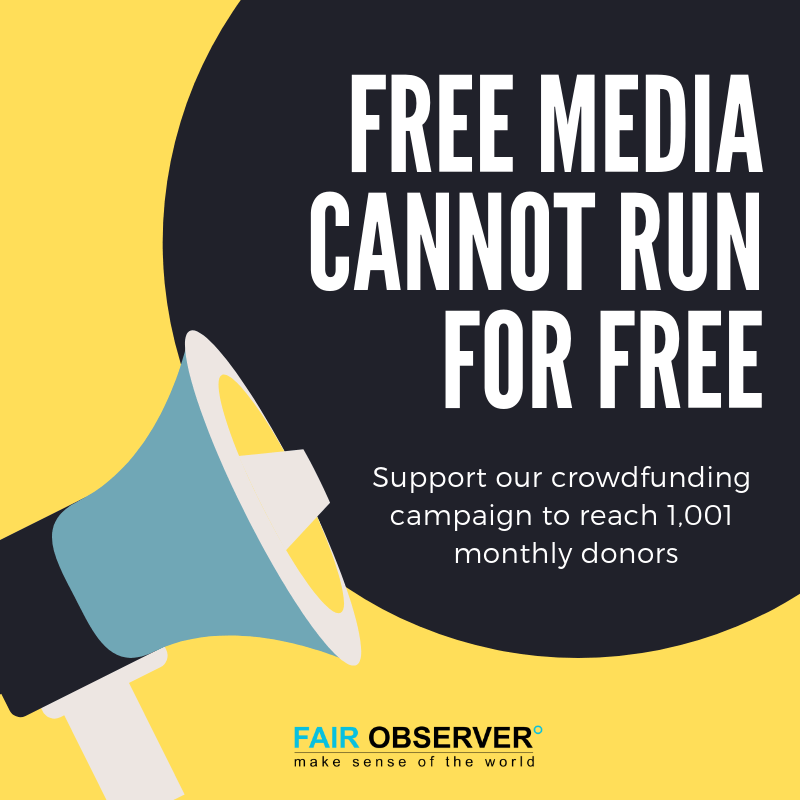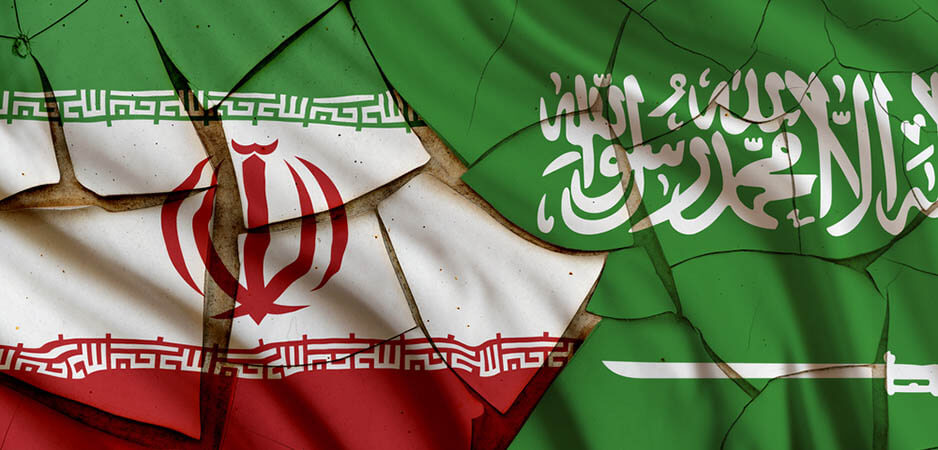In this edition of The Interview, Fair Observer talks to Nader Hashemi, director of the Center for Middle East Studies at the Josef Korbel School of International Studies, University of Denver.
The rivalry between Iran and the Arab world is nothing new. The 1979 revolution turned the previously friendly ties between Iranians and Arabs into a situation of regional competition and proxy conflicts. The most bitter moment came in the 1980s with the Iran-Iraq War, which claimed over a million lives.
There have been points in recent history when Iran held amicable relations with Arab countries, especially under the presidencies of Akbar Hashemi Rafsanjani and Mohammad Khatami. The presidency of hardliner Mahmoud Ahmadinejad was the moment that Iranian-Arab ties hit an all-time low and that post-1979 rivalries turned into outright hostility.
In 2016, a group of religious extremists attacked and ransacked the Saudi Arabian Embassy in Tehran and the Saudi Consulate in Mashhad. Soon after, Saudi Arabia and five other countries cut diplomatic relations with Iran. In 2009, Morocco severed ties with Iran over claims that the Iranians were spreading Shia ideology in the Sunni kingdom and undermining the national security of the country.
Today, Iran and Saudi Arabia are involved in a proxy war in Yemen, while Tehran’s role in countries such as Syria, Lebanon and Palestine is heavily criticized by the international community. Both Arab leaders and Western observers say Iran is on a quest to export its Islamic Revolution across the Middle East.
In this edition of The Interview, Fair Observer talks to Nader Hashemi, director of the Center for Middle East Studies at the University of Denver, about Iran’s complex relations with the Arab world.
The transcript has been edited for clarity.
Kourosh Ziabari: Do you think the rivalry between Iran and the Arab world, especially Saudi Arabia, has historical explanations?
Nader Hashemi: Yes, but the rivalry between Iran and the Arab world has its roots in modern history. In other words, the “ancient sectarian hatred” thesis that is widely believed in the West is a form of intellectual laziness that explains very little about Saudi-Iran relations today. Sadly, President Barack Obama was a key proponent of this argument. Danny Postel and I debunk this thesis in some detail in our book, Sectarianization: Mapping the New Politics of the Middle East.
The Saudi-Iran rivalry begins after the 1979 Iranian Revolution. Before then, Iran and Saudi Arabia were both pro-Western monarchies who had good relations and shared a similar worldview in terms of perceived threats and sources of instability in the Middle East. The civil war in Yemen in the early 1960s is a perfect example to cite in this regard. Both Iran and Saudi Arabia were on the same side of this war supporting the Zaydi Shia Mutawakkilite kingdom [North Yemen] against the republican forces backed by Gamal Abdel Nasser’s Egypt.
At this moment, sectarianism was not factor in the politics of the Middle East. The key fault lines were ideology, regime type, namely monarchy vs. republic and Cold War alliances. All of this changed after 1979, when the Saudis and their allies sought to diminish the power and appeal of the Iranian Revolution by playing the sectarianism card.
Ziabari: In popular culture, Iranians and Arabs continue to insult each other in a racist way. There are Iranians who refer to Arabs as “locust eaters” or “lizard eaters” and refer to them as “tazis.” In return, there are Arabs who call Iranians majus, fire-worshipers, infidels and “ajam.” Has this rhetoric been challenged by daily people-to-people relations between the two sides?
Hashemi: To my knowledge, there is very little challenge to this form of mutual defamation and crass bigotry. One problem is there is very little interaction and connection between Iranians and Arabs. While language is a problem, the bigger problem is the landscape of political authoritarianism that dominates the region. This prevents Iranians and Arabs from freely meeting and mixing, and it creates an environment where mutual defamation and demonization can flourish.
Ruling regimes have little interest or incentive in challenging defamation, bigotry and prejudice. They exert little effort to combat these trends. I would argue, given deep regional rivalries among the ruling elites of the Middle East, not the people, authoritarian regimes benefit from these tensions as a way of directing attention from their own internal failures and crises of legitimacy onto outside groups that allegedly seek to dominate them.
In popular culture, the defamation of Iranians by Arabs, and vice versa, can be understood in historic and comparative terms. German-French relations involved similar problems that had historical roots, produced lots of bloodshed and two world wars. This gradually changed but, critically, change was only possible in the context of democracy, where people were free to debate, travel, critique and to challenge stereotypes and prejudice in the public sphere.
Finally, I would add that what is needed is a process of engendering a culture of mutual respect backed by state resources. This takes time, commitment and patience. It also requires moral leadership to confront chauvinistic forms of nationalism. There is nothing inevitable or natural about Arab-Iranian tensions; they can be mitigated and resolved. At the end of the day, Iranians and Arabs have a lot more in common than the differences that separate them.
Ziabari: Do you see discrimination against the Arab minority of Iran in the southern provinces in the context of the broader conflicts between Iran and the Arab world? Are Iran’s Arabs being kept at a disadvantage because the government in Tehran is not happy about them being empowered?
Hashemi: I see this problem in the context of political authoritarianism in Iran. It is first and foremost a structural problem rooted in the nature and distribution of power within Iran’s political system. In this context, minority groups are not free to protest, lobby and publicly demonstrate for their rights. Elections are not free and fair. The central government, and the ruling elites that control it, is not incentivized to fully respond to citizens’ demands; if it was, this problem could be ameliorated over time.
You do raise an important point in your question about how regional rivalries overlap with this problem. I think governments that are hostile to the Islamic Republic see an opportunity to exploit the legitimate grievances of Iran’s Arab minority to destabilize Iran and to score propaganda points. It is a mirror image reflection of a policy that Tehran has utilized to expand its influence in the Middle East. In other words, to seek out opportunities, where there are local grievances, to insert itself to weaken regional rivals and advance its national interests. Iran’s role in Yemen today is a perfect illustration of this policy.
Ziabari: Do the governments of Iran and Arab countries in the Persian Gulf foment anti-Arab and anti-Iranian sentiments for political gains?
Hashemi: Yes they do, but this activity is implicit not explicit. In other words, there is no official policy that one can directly point to. Saudi Arabia and its Gulf Cooperation Council (GCC) allies do not regularly target Iranian ethnicity; rather, the target is primarily Tehran’s regional behavior. These countries, especially Saudi Arabia, the United Arab Emirates and Bahrain, also foment and promote sectarianism, which often overlaps with ethnic defamation. This is a strategy of regime survival that is deliberately adopted by authoritarian regimes for reasons that we explain in our book.
These observations also apply to policies of the Islamic Republic. I would argue that Iran is more sensitive on this matter, for reasons of self-interest, in the sense that since the 1979 revolution, Tehran has sought to project its soft power throughout a region that is mostly Sunni Arab. Officially promoting anti-Arab sentiments or sectarianism would be self-defeating for the regime. Iran’s regional policies, however, do inadvertently contribute to sectarianism, especially in Syria and Iraq. By supporting repressive regimes and Shia militias that engage in sectarian killings, Tehran is rightly blamed for its political, military and financial support for these actors.
Ziabari: Is it realistic to lay the blame for current tensions between Iran and the Arab world at Iran’s door because it’s believed to be interfering in the internal affairs of Arab countries and getting involved in issues such as the Israeli-Palestinian conflict?
Hashemi: There is a lot a blame to go around and it cannot all be laid at the doorstep of Iran. As we are seeing right now, Saudi Arabia, especially under Crown Prince Mohammad bin Salman, is a huge part of the problem. Both sides of this regional rivalry are guilty of destabilizing the region. I do not believe that blanket statements and gratuitous generalizations help us here. We need to make distinctions.
In Syria, Iran is directly responsible for involvement in and contributing to war crimes and crimes against humanity on a colossal scale that have killed half a million people and created over 5 million refugees. In Yemen, Saudi Arabia is guilty of war crimes and the starvation of the Yemeni people. The aid organization Save the Children recently reported that 85,000 children under the age of 5 had died in Yemen during the last three years. They note that this was a conservative estimate. Saudi Arabia bears direct moral and legal responsibility for this situation.
Ziabari: There were points in the modern history of Iran, namely the presidencies of Ayatollah Hashemi Rafsanjani and Mohammad Khatami, when Iran and the Arab world had almost steady and robust relations. Why did this change and instead give rise to hostility and animosity?
Hashemi: You are absolutely correct to draw attention to the fact that, not long ago, Iran and Saudi Arabia had relatively amicable relations. This highlights the fact that current tensions are a function of contemporary politics and not of “ancient sectarian differences.”
 After the end of the Iran-Iraq War in 1988 and the death of Ayatollah Ruhollah Khomeini in 1989, Iran’s revolutionary aspirations were drawn inward and the regime’s focus was on economic reconstruction. The election of pragmatic and reformists presidents in Iran during the 1990s led to a reduction of regional tensions and the re-establishment of diplomatic relations between Iran and Saudi Arabia. In 1997, at the Organization of Islamic Cooperation meeting in Tehran, Riyadh sent a high-level delegation — crown prince and foreign minister. Rafsanjani and Khatami made reciprocal visits to Saudi Arabia during this period. Animosity toward Iraq’s Saddam Hussein, who in 1990 invaded Kuwait, helped bring the two sides together.
After the end of the Iran-Iraq War in 1988 and the death of Ayatollah Ruhollah Khomeini in 1989, Iran’s revolutionary aspirations were drawn inward and the regime’s focus was on economic reconstruction. The election of pragmatic and reformists presidents in Iran during the 1990s led to a reduction of regional tensions and the re-establishment of diplomatic relations between Iran and Saudi Arabia. In 1997, at the Organization of Islamic Cooperation meeting in Tehran, Riyadh sent a high-level delegation — crown prince and foreign minister. Rafsanjani and Khatami made reciprocal visits to Saudi Arabia during this period. Animosity toward Iraq’s Saddam Hussein, who in 1990 invaded Kuwait, helped bring the two sides together.
Everything changed in 2003. The key event was the American invasion and occupation of Iraq, followed by the rise of Shia political parties with close ties to Iran. This event changed the regional balance of power in the Middle East. The Saudis started to panic.
A related development was the rise and growing prestige of Hezbollah in Lebanon — in the Sunni Arab world. Near this time, Hezbollah had expelled Israel from southern Lebanon, resulting in its growing popularity among Sunni Arabs. The contrast between Hassan Nasrallah’s defiant speeches — which played on themes of anti-imperialism, anti-Zionism and support for Palestinian rights — and the corrupt and compliant pro-Western dictators that ruled the Arab world was stark. As a result of these developments, warnings of the “Shia crescent” taking over the region began to be heard in various Arab capitals.
The actual fear from Saudi Arabia and its allies was not Iranian or Shia occupation of the Arab world. Rather it was the spread and legitimation of political Islam throughout the region that sought to bring about political change that would challenge the Western-backed Arab authoritarian status quo. Due to these developments, after 2003, relations between Iran, Saudi Arabia and its allies steadily deteriorated. The 2011 Arab Spring uprisings damaged these relationships further.
Ziabari: Will things change for the better between Iran and the Arab world if Tehran takes steps such as stopping its sponsorship of groups like Lebanon’s Hezbollah or Palestine’s Hamas, retreating from Syria and halting its role in Yemen?
Hashemi: If Iran were to adopt these policies, then I think it would certainly help reduce regional tensions. The problem with your suggestion is that the probability of Iran reversing its regional foreign policy along these lines is close to zero. In the case of Hezbollah and Syria, Iran views its investment and intervention in Lebanon and Syria as vital to its national security and deterrence doctrine against Israel and the US. It is for this reason that Iran is so invested in supporting these actors and is not likely to reverse course.
Furthermore, the rise of Mohammad bin Salman has made a reduction in tensions next to impossible. If Iran were to adopt the changes you suggest, it would have a little impact on those tensions. Recall that in 2018 on his trip to the US, Mohammad bin Salman repeatedly compared Iran to Nazi Germany and described Iran’s supreme leader as being “worse than” Adolf Hitler. Rhetoric like this suggests that only regime change in Iran would satisfy the de facto leader of Saudi Arabia.
Ziabari: There were two points in recent years when the Moroccan government severed bilateral relations with Iran. How do you see the ups and downs of Iran’s relations with Morocco as a major Muslim nation and emerging power in the Arab world?
Hashemi: This is really a bizarre story. There is little substantial evidence that Iran has invested any significant resources in Morocco or that there is a substantial Shia presence that might explain these tensions. My evaluation is the following: There are problems from below in society and from the top at the state that explain this development.
At the societal level, the spread of ultraconservative Salafi Islam is a factor. Theologically, this version of Islam has deep Wahhabi roots and, as a result, it is decidedly anti-Shia in orientation. Anti-Shia paranoia is a key part of the Salafi-Wahhabi worldview. At the level of the state, Morocco benefits politically from standing up to Iran and claiming it has neutralized an Iranian threat. Saudi Arabia and the UAE welcome rhetoric like this as it lines up with their own threat perceptions. The Israeli right as well as Republicans and neoconservatives in Washington, DC, share a similar view. By presenting itself as a frontline state confronting the “Shia crescent,” Morocco hopes to derive economic and security benefits and guarantees from its allies.
The views expressed in this article are the author’s own and do not necessarily reflect Fair Observer’s editorial policy.
Support Fair Observer
We rely on your support for our independence, diversity and quality.
For more than 10 years, Fair Observer has been free, fair and independent. No billionaire owns us, no advertisers control us. We are a reader-supported nonprofit. Unlike many other publications, we keep our content free for readers regardless of where they live or whether they can afford to pay. We have no paywalls and no ads.
In the post-truth era of fake news, echo chambers and filter bubbles, we publish a plurality of perspectives from around the world. Anyone can publish with us, but everyone goes through a rigorous editorial process. So, you get fact-checked, well-reasoned content instead of noise.
We publish 2,500+ voices from 90+ countries. We also conduct education and training programs
on subjects ranging from digital media and journalism to writing and critical thinking. This
doesn’t come cheap. Servers, editors, trainers and web developers cost
money.
Please consider supporting us on a regular basis as a recurring donor or a
sustaining member.
Will you support FO’s journalism?
We rely on your support for our independence, diversity and quality.






